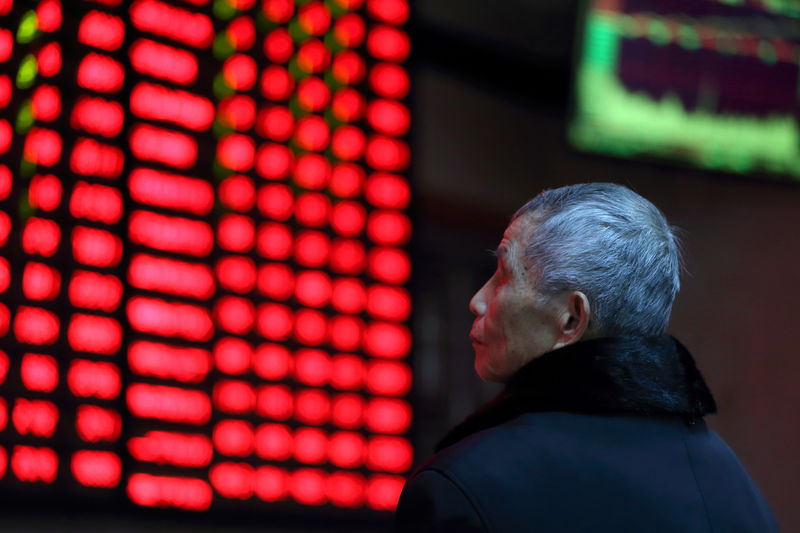By Luoyan Liu and Andrew Galbraith
SHANGHAI (Reuters) - Chinese stocks have staged a robust rebound this year, unexpectedly recouping much of 2018's sharp losses, buoyed by hopes Beijing will roll out more support measures for the slowing economy and signs of progress in Sino-U.S. trade talks.
Adding fuel to the rally is a pick up in the momentum in the A-share market's internationalization process, which drew foreign money into China even as authorities vowed to further open up its financial markets and deepen reforms.
The benchmark Shanghai composite index SSEC gained 17.9 percent in the first two months of 2019, versus an 8.2 percent rise in MSCI's broadest index of Asia-Pacific shares in the same period.
(For a graphic on 'Shanghai benchmark VS. MSCI Asia Pacific' click https://tmsnrt.rs/2Ul6URs)
Growth in the world's second largest economy cooled to a 28-year low in 2018, and authorities have announced a flurry of measures in recent months to reduce the risk of a sharper slowdown.
China will cut billions of dollars more in taxes and fees, increase infrastructure investment, and step up lending to small firms, Premier Li Keqiang said on Tuesday.
In a move to further lower financing costs and spur growth, China's central bank in October announced a steep cut in the level of cash that banks must hold as reserves, its fourth in 2018.
There have been signs of credit easing. China's banks made the most new loans on record in January - totaling 3.23 trillion yuan ($482.58 billion), as policymakers try to jumpstart sluggish investment.
Proposed subsidies on items such as appliances have helped push up China's consumer firms, which have long been liked by foreigners, with the CSI consumer staples index having gained nearly 30 percent this year.
(For a graphic on 'RRR cuts amid gdp slowdow' click https://tmsnrt.rs/2VEObkb)
Market participants were also encouraged by the developments in Sino-U.S. trade talks.
U.S. Secretary of State Mike Pompeo said on Monday he thought the United States and China were "on the cusp" of a deal to end their trade war, adding to positive signs about negotiations from both sides of the Pacific.
Analysts say a trade deal would be no panacea for China's ailing economy, but it would relieve some pressure on its exporters and manufacturers and help business confidence.
TECH TOPS
At the forefront of the rebound, technology firms soared as Beijing continues its push to reduce dependence on foreign technology and to upgrade its industries.
China has finalised regulations for a new tech board that promises to smooth the way for Chinese technology IPOs and, if successful, could raise Shanghai's profile as a capital-raising competitor to Hong Kong and New York.
As of March 4, the CSI information technology index had surged nearly 40 percent so far this year, while an index tracking major telecoms firms had also advanced more than 30 percent.
The tech-heavy start-up board ChiNextp shot up 30 percent so far this year, up to Monday.
Financial firms also shone, with the CSI300 financials index up nearly 30 percent this year, as investors cheered Beijing's plan to deepen supply-side reforms in the sector, counting finance as a key part of its core competitiveness.
(For a graphic on 'China's tech firms lead charge' click https://tmsnrt.rs/2C3jnlK)
INFLOWS
Also powering the rally is a surge in foreign inflows, a not yet dominant though increasingly significant force in the A-share market, just as the country further deregulates its capital markets.
Net flows into the Shanghai and Shenzhen stock markets via the Stock Connect scheme as of end February topped 120 billion yuan, nearly four times that in the first two months of 2018.
In late January, China said it would ease foreign institutions' access by combining two inbound investment schemes, while broadening their investment scope to include derivatives, bond repurchases and private funds.
Global index provider MSCI said it will quadruple the weighting of Chinese mainland shares in its global benchmarks later this year, potentially drawing more than $80 billion of fresh foreign inflows to the world's second-biggest economy.
"Foreign investors as a group have surpassed insurers as the largest A-share holder, and with the help of the MSCI weight increase, are likely to rival domestic mutual funds soon," Gao Ting, Head of China Strategy at UBS Securities noted in report.
(For a graphic on 'Jan-Feb foreign inflows into the A-share market' click https://tmsnrt.rs/2C6nu0j)
(For a graphic on 'Foreign investors hiked their holdings of Chinese equities in the past five years' click https://tmsnrt.rs/2VGQ93z)
Investors are also being attracted by the cheapness of mainland stocks, whose valuations many say are near record lows by historical standards.
Even after the rally, Chinese mainland shares are still relatively cheap by historical and international standards.
SSEC currently trades at 12.7 times earnings, compared with an earning multiple of roughly 18 for the Dow Jones Industrial Average.
Leveraging is also back with a vengeance in China's stock markets as regulators shift their focus back to growth after a lengthy clampdown on riskier types of financing.
Margin loans, seen as a barometer of risk appetite and sentiment as aggressive investors borrow to buy stocks, reached more than 800 billion yuan as of early this week.

(For a graphic on Shanghai A-share PE ratio and margin lending' click https://tmsnrt.rs/2Vw7AU4)